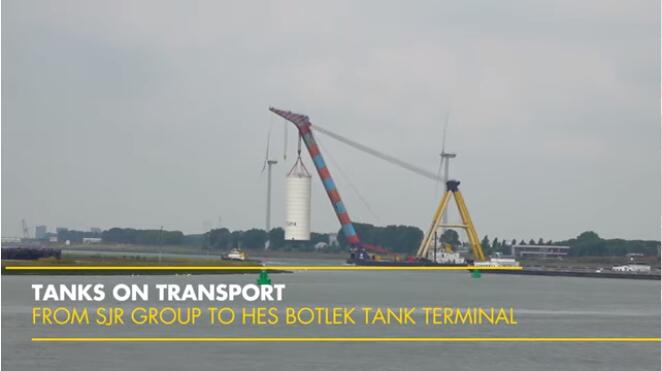Article by Port of Rotterdam:
A remarkable transport by water in the port of Rotterdam: six tanks were transported this week by floating sheerlegs from the production hall where they were built to the terminal where they will soon be used for the storage of biofuels.

A thirty meter high tank hanging in the ridge of a floating sheerlegs. It was not an everyday sight, last Thursday and Friday on the water of the Nieuwe Waterweg. On these days, a total of six tanks travelled the route from tank builder SJR Group on Heijplaat to HES Botlek Tank Terminal (HBTT) in the Botlek harbour.
Fitting and measuring
A piece of logistics art, because along the way the necessary obstacles had to be overcome. It all started in the production hall where the tanks with a diameter of 12 metres were welded together over the past few months, says project leader Anne Vonk Noordegraaf of SJR Group. With a height of thirty metres, these tanks are quite up to scratch. They only just fitted through the doorway of our warehouse. With the construction for the transport around it, we had a few centimetres of room for manoeuvre. So fit and measure!
Floating sheerlegs
Road transport of such dangers is not an option, so the transport is by water. This is done with a ‘floating sheerlegs’, an extremely strong, floating crane, in this case the HEBO Lift-9. A bit of power is needed too, given the 110,000 kilograms that each tank weighs. After that it is one and a half hour sailing to the HES Botlek Tank Terminal. Here is another special vehicle: a Self-Propelled Modular Transporter (SPMT), a gigantic trailer supported by endless wheels. When they arrive at their final destination, a crawler crane lifts each tank onto the foundation, after which they can be connected.
140 Olympic swimming pools
With the six new tanks, HBTT expands its tank capacity by 20,000 cubic metres in one go. This will give us a total storage capacity of 510,000 cubic metres,’ says Coen Janssen of HBTT. By way of comparison, that’s about the capacity of some 140 Olympic swimming pools. The new tanks are badly needed, because the demand for storage in the port is high, says Coen. Especially for biofuels, for which these new tanks are intended. The supply or transport takes place by ship, truck or train, after which we temporarily store the ‘liquid bulk’ for the customer. Subsequent transport is also by water, road or rail’.
Rotterdam tank builder
Special attention was paid to the storage of biofuels in the design of the tanks. For example, they contain a heating coil, which prevents the contents from clotting,’ Anne explains. Now that the tanks are in place, SJR Group is embarking on the final part of the delivery: the connection and testing of the tanks. We do this with water, paying attention to leaks and misalignment, among other things.
Once that process has been completed, the tanks are ready for use.
They are right next to the motorway – I will be happy to look at them when I drive past them’, concludes Anne: ‘A nice billboard for us as a tank builder in Rotterdam’.
Guest contributors are welcome at the Alloy Wiki.It is a weekly wiki and guide on alloy information and processing technology, while also about the vast array of opportunities that are present in manufacturing. Our team of writers consists of a Machining Material Supplier / Machinist / Tool and Die Maker, a Biomedical Engineer / Product Development Engineer, a Job Development Coordinator / Adjunct Professor, and a President and CEO of a manufacturing facility.
Link to this article:Special Tank Transport in the Port of Rotterdam
Reprint Statement: If there are no special instructions, all articles on this site are original. Please indicate the source for reprinting:Alloy Wiki,thanks!^^


